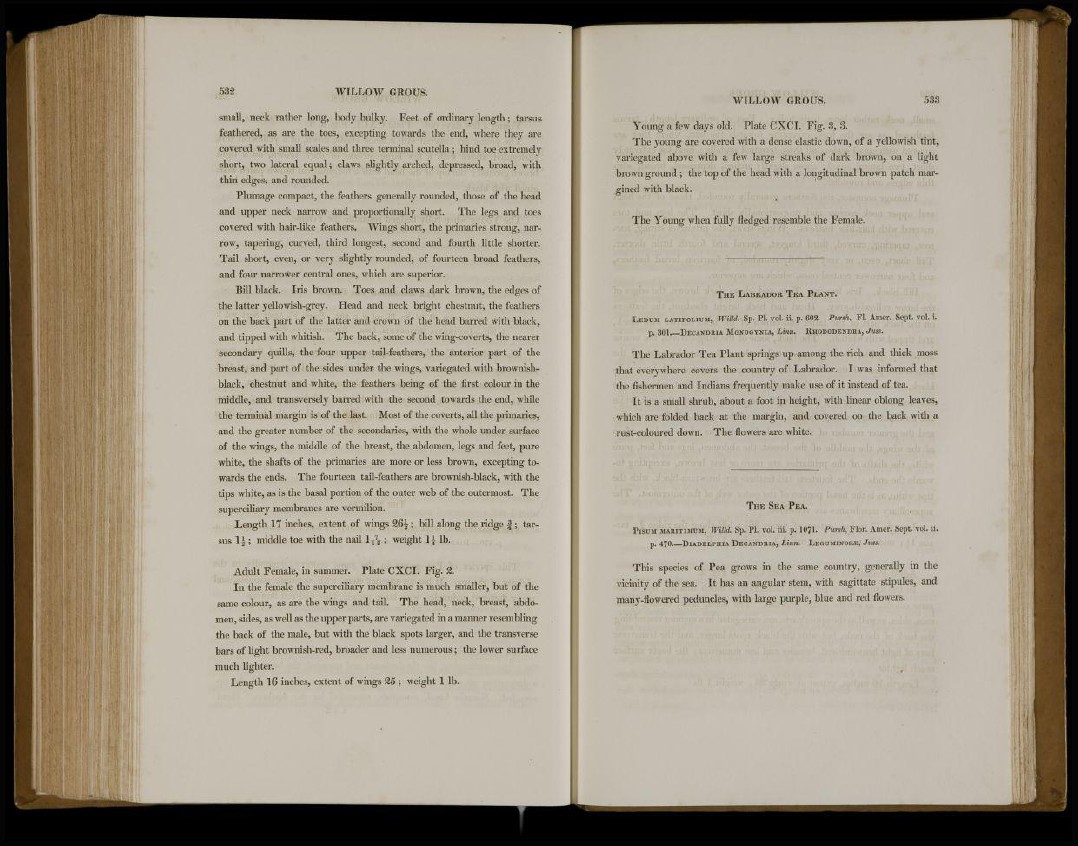
532 W I L L O W GROUS.
small, neck rather long, body bulky. Feet of ordinary length; tarsus
feathered, as are the toes, excepting towards the end, where they are
covered with small scales and three terminal scutella ; hind toe extremely
short, two lateral equal; claws slightly arched, depressed, broad, with
thin edges, and rounded.
Plumage compact, the feathers generally rounded, those of the head
and upper neck narrow and proportionally short. The legs and toes
covered with hair-like feathers. Wings short, the primaries strong, narrow,
tapering, curved, third longest, second and fourth little shorter.
Tail short, even, or very slightly rounded, of fourteen broad feathers,
and four narrower central ones, which are superior.
Bill black. Iris brown. Toes and claws dark brown, the edges of
the latter yellowish-grey. Head and neck bright chestnut, the feathers
on the back part of the latter and crown of the head barred with black,
and tipped with whitish. The back, some of the wing-coverts, the nearer
secondary quills, the four upper tail-feathers, the anterior part of the
breast, and part of the sides under the wings, variegated with brownishblack,
chestnut and white, the feathers being of the first colour in the
middle, and transversely barred with the second towards the end, while
the terminal margin is of the last. Most of the coverts, all the primaries,
and the greater number of the secondaries, with the whole under surface
of the wings, the middle of the breast, the abdomen, legs and feet, pure
white, the shafts of the primaries are more or less brown, excepting towards
the ends. The fourteen tail-feathers are brownish-black, with the
tips white, as is the basal portion of the outer web of the outermost. The
superciliary membranes are vermilion.
Length 17 inches, extent of wings 26^; bill along the ridge f; tarsus
1 | ; middle toe with the nail 17
S ; weight 1 | lb.
T
Adult Female, in summer. Plate CXCI. Fig. 2.
In the female the superciliary membrane is much smaller, but of the
same colour, as are the wings and tail. The head, neck, breast, abdomen,
sides, as well as the upper parts, are variegated in a manner resembling
the back of the male, but with the black spots larger, and the transverse
bars of light brownish-red, broader and less numerous; the lower surface
much lighter.
Length 16 inches, extent of wings 25 ; weight 1 lb.
Young a few days old. Plate CXCI. Fig. 3, 3.
The young are covered with a dense elastic down, of a yellowish tint,
variegated above with a few large streaks of dark brown, on a light
brown ground ; the top of the head with a longitudinal brown patch margined
with black.
The Young when fully fledged resemble the Female.
THE LABRADOR TEA PLANT.
LEDUM LATIFOLIUM, Willd. Sp. PL vol. ii. p. 602. PursK FL Amer. Sept. vol. i.
p. 301.—DECANDRIA MONOGYNIA, Linn. HIIODODENDRA, JUSS.
The Labrador Tea Plant springs up among the rich and thick moss
that everywhere covers the country of Labrador. I was informed that
the fishermen and Indians frequently make use of it instead of tea.
It is a small shrub, about a foot in height, with linear oblong leaves,
which are folded back at the margin, and covered on the back with a
rust-coloured down. The flowers are white.
THE SEA PEA.
PISUM MARITIMUM, Willd. Sp. PI. vol. iii. p. 1071. Pursh, Flor. Amer. Sept. vol. ii.
p. 470. DlADELPHIA DECAXDRIA, Lilin. LEGUMINOSiE, JuSS.
This species of Pea grows in the same country, generally in the
vicinity of the sea. It has an angular stem, with sagittate stipules, and
many-flowered peduncles, with large purple, blue and red flowers.